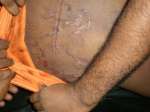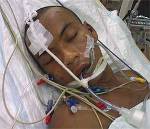 Helen Ang’s compelling column article “Placating Kugan’s Ghost” raised a valid question about the bewildering amount of medical jargon used by the Director-General of Health, Tan Sri Datuk Haji Dr Ismail Haji Mohd Merican, when the Health Ministry presented the findings of its official inquiry into the cause of Kugan’s death.
Helen Ang’s compelling column article “Placating Kugan’s Ghost” raised a valid question about the bewildering amount of medical jargon used by the Director-General of Health, Tan Sri Datuk Haji Dr Ismail Haji Mohd Merican, when the Health Ministry presented the findings of its official inquiry into the cause of Kugan’s death.

 It is a matter of national importance, as well as personal importance for Kugan’s bereaved family, to try to shed some light into the dense fog generated by all this professional jargon. The Bernama report of the Health Ministry’s announcement quoted the Director-General as saying that Kugan Ananthan, 22, died of fluid in the lungs (“pulmonary oedema”), caused by inflammation of the heart muscle (“myocarditis”). The inquiry asserted that there had been blunt force injuries to Kugan’s body but these “were insufficient to cause death directly”, as there were no broken bones or ruptured internal organs. The Director-General mentioned that myocarditis is a well-recognised cause of sudden death in young people. The Ministry’s findings were based on the post-mortem report produced by the Ministry’s forensic expert, Senior Forensic Pathologist, Dr Abdul Karim Tajuddin, from Serdang Hospital in Selangor .
It is a matter of national importance, as well as personal importance for Kugan’s bereaved family, to try to shed some light into the dense fog generated by all this professional jargon. The Bernama report of the Health Ministry’s announcement quoted the Director-General as saying that Kugan Ananthan, 22, died of fluid in the lungs (“pulmonary oedema”), caused by inflammation of the heart muscle (“myocarditis”). The inquiry asserted that there had been blunt force injuries to Kugan’s body but these “were insufficient to cause death directly”, as there were no broken bones or ruptured internal organs. The Director-General mentioned that myocarditis is a well-recognised cause of sudden death in young people. The Ministry’s findings were based on the post-mortem report produced by the Ministry’s forensic expert, Senior Forensic Pathologist, Dr Abdul Karim Tajuddin, from Serdang Hospital in Selangor .
On the other hand, Universiti Malaya Medical Centre Pathologist, Dr Prashant N Samberker, who had examined Kugan’s body at the request of Kugan’s family, concluded that death had resulted from acute renal (kidney) failure. The kidney failure was caused by rhabdomyolysis, Dr Prashant reported, due to blunt trauma to the muscles. Rhabdomyolysis, or muscle breakdown, is a well-recognised result of trauma to the muscles, especially with prolonged or repeated injuries. Rhabdomyolysis releases poisons from injured or dead muscles into the blood, and the poisons cause kidney failure. Kidney failure, in turn, can cause inflammation of the heart lining, and can cause pulmonary oedema. If the kidneys shut down, fluid cannot be removed from the body in the urine, and fluid can then accumulate in the lungs. Kugan was detained and interrogated for five days before he died: more than enough time for severe kidney failure and fluid retention to develop.
The Health Ministry did not contradict Dr Prashant’s findings of acute renal (kidney) failure. The Director-General was quoted by Bernama as admitting that blunt force trauma could have led to acute renal failure, “aggravating” the acute myocarditis, and resulting in acute pulmonary oedema.
A jargon-free explanation
In short, the two post-mortem reports are not mutually exclusive. The information given to the media by the Health Ministry’s inquiry into Kugan’s death is consistent with the chain of events put forward by Dr Prashant. It is entirely consistent with the Health Ministry’s own findings, that Kugan was beaten repeatedly until his muscles broke down and damaged his kidneys, which in turn led to his death from the retention of fluid in the lungs, and that the beatings caused death indirectly.
The Health Ministry Director-General would still be correct in his assertion that blunt trauma did not cause death “directly”, because the beatings did not cause internal bleeding or broken bones. Does this mean that causing death “indirectly” would, somehow, be more acceptable?
Let us turn to the idea that Kugan’s so-called “sudden death” resulted from myocarditis, while drinking a glass of water. The idea was not spelled out by the Health Ministry. The Director-General of Health alluded to it when he pointed out that myocarditis is a common cause of sudden death in young people. This is indeed true, but even medical students will tell you that myocarditis does not develop over a few seconds – “suddenly” – like a heart attack or myocardial infarction (which sounds a little like myocarditis, but is a different disease altogether, caused by blockage of blood supply to the heart muscle). Myocarditis would not, therefore, cause someone’s lungs to fill instantaneously with fluid, so that he or she dies while drinking a glass of water. Myocarditis develops over hours to weeks, because of illnesses such as infections, poisons or other causes.
Even if myocarditis had developed, by some coincidence, before or during Kugan’s detention, surely he would have experienced symptoms, assuming the myocarditis had been severe enough to cause death. Such myocarditis symptoms include severe, progressive breathlessness. To argue that the policemen interrogating him would not have noticed Kugan’s distress from such symptoms would be farcical. Therefore, even if Kugan had somehow, by some coincidence, developed myocarditis before or during his detention, it would have become obvious that Kugan needed medical attention. The policemen would have been negligent to carry on with his interrogation and detention, even if we accept this hypothesis.
Instead, the police initially said Kugan’s death resulted from choking on a glass of water. The explanation was not very sophisticated, but they did not have much access to medical jargon at the time.
To recap, and to try to clear the professional jargon: Kugan Ananthan, a previously healthy 22 year old Malaysian, died in police custody, with evidence of having being beaten. The beatings may not have caused death directly, but all medical textbooks lay out the chain of events proposed by the UMMC Pathologist: from prolonged or repeated injuries, to muscle breakdown, to kidney failure, to fluid accumulation in the lungs, so that Kugan could not breathe. The Director-General of Health admitted kidney failure could have taken place due to the beatings, yet he insisted “myocarditis” was the cause of death. He stated with certainty that inflammation of the heart muscle, of unspecified cause, led to the retention of fluid in the lungs, and kidney failure might have only been an “aggravating” factor.
Adi Anwar’s injuries show a pattern of abuse
While Kugan’s family were still saying their prayers of mourning, another young Malaysian, Adi Anwar Mansor, 23, was beaten brutally until he lay unconscious in an ICU in Klang. “He was kicked on his back, hit on the back of his head and hit with a rubber hose until he could not take the pain,” said Jiknah Harun, 49, the thin, ashen-faced mother of Adi Anwar.
The police claimed initially Adi Anwar’s injuries were due to a scuffle at the time of arrest, and he became unconscious after drinking paint thinner while under police custody. Again, the explanation was not very sophisticated. What “spin” can be put on the pictures of the lacerations, bruises and black eye, with the breathing tube sticking out of his mouth in ICU?
The pictures of Kugan and Adi Anwar’s injuries suggest both young Malaysians were beaten with a long, blunt object, leaving angry wheals and stripes.
We can only conclude these two young men were whipped, and tortured.
Why torture young Malaysians?
Torture is traditionally performed to extract information or concessions. What plausible reason could be given for torture to have been used on these young men? The Police are under tremendous pressure to solve crimes and ensure convictions. The temptation would be tremendous, in order to achieve these goals, and produce positive statistics, to extract confessions.
Many letters written to Malaysiakini and mainstream newspapers argue that Kugan was a “criminal”, and that violence applied to criminals protects society at large. Kugan and Adi Anwar had not even been charged in court and had never been found guilty. They were innocent until proven guilty. And even if Kugan had been convicted of car theft, would torture and death have been a just punishment?
Max Weber argued that the State only exists when it can uphold a claim on the monopoly of the legitimate use of violence. Was the violence used against Kugan and Adi Anwar legitimate? Malaysia has never seen fit to ratify the United Nations (UN) Convention against Torture and Other Cruel, Inhuman or Degrading Treatment or Punishment, unlike 123 out of 192 UN members.
Low-income people with limited education, like Adi Anwar’s parents and Kugan’s family, have spoken up for their children, and for all Malaysians. Why did the medical profession not speak out for Kugan’s family, and Adi Anwar’s? The Bar Council has been vocal over these abuses, but the Malaysian Medical Association has remained quiet and docile.
The Royal Police Commission called, in 2005, for fast, transparent investigations into every single case of “custodial death”. The Commission urged the government to reform or repeal certain laws allowing arbitrary search and seizure, and remand without trial. The Royal Police Commission called for an Independent Police Complaints and Misconduct Commission. None of these recommendations has borne fruit.
What are we to do ourselves, as educated Malaysians? Will we educated Malaysians stand up and fight, for a better police force to protect our children? Will we improve political leadership, so that we can one day have a Police Service for our community, and not a Police Force of state-sanctioned violence?
Do we Malaysians have the collective courage to reduce the huge income disparity in our lop-sided society, so that crime does not continue to flourish among the poor? Do we have the will to compel our politicians to carry out all the Royal Police Commission’s recommendations, and ratify the UN Convention against Torture?
Until these questions are answered, we cannot blame the police alone for the miserable state of crime and punishment – and torture – in our society. Unless we respond, Kugan’s death will be forgotten, and the suffering of Kugan’s bereaved family and of Adi Anwar’s horrified parents, will be hidden away.
p/s: Hornbill Unleashed invites readers to email us at hueditor@gmail.com with leads and or other specific information on individuals involved in related to the above article so that we know more concretely about the matter. Thank You.
.






















We need a new law enforcement unit staffed by an entirely new generation competent, compassionate, trustworthy and well-paid officers.
If I were the new government, that’s what I would do. Leave PDRM to office desks or cleaning weapons and maintaining their bikes.
Comment by Borneonization — May 2, 2009 @ 11:30 AM |